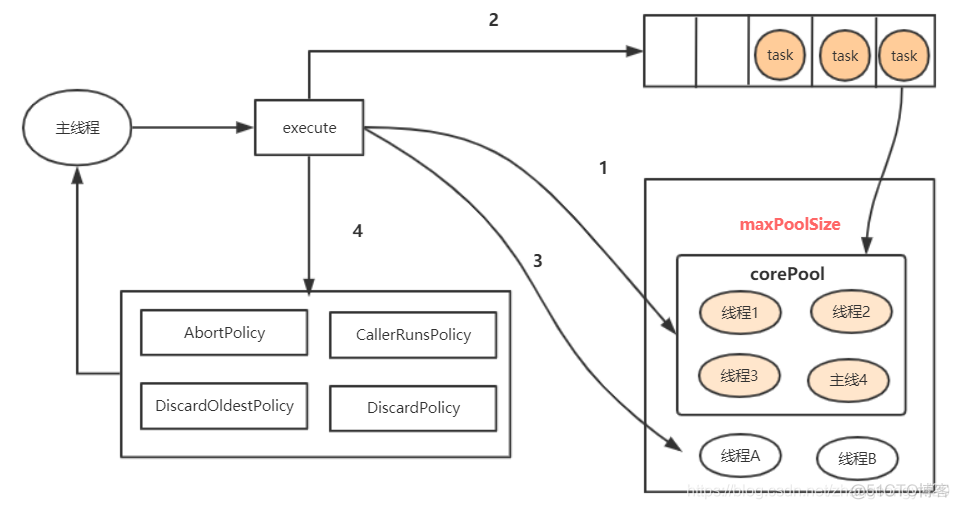Java线程池调优:性能优化的10大秘籍
发布时间: 2024-09-10 22:38:27 阅读量: 23 订阅数: 32 


# 1. Java线程池核心概念解析
在多线程编程中,Java线程池作为一种重要的资源复用机制,它通过预先创建一定数量的工作线程,并将任务提交给这些线程去执行,从而减少频繁创建和销毁线程带来的性能开销。本章将从线程池的定义入手,深入探讨其核心概念,为读者全面了解线程池的工作原理和优势打下坚实基础。
## 1.1 线程池的定义与作用
线程池是一组可重用线程的集合,用于执行提交的任务。使用线程池的主要目的是降低资源消耗,提高线程处理效率,并且能够有效管理线程的生命周期。它能够控制并发的数量,使系统中的并发线程数量始终保持在一个合理的水平上。
## 1.2 线程池的工作机制
Java线程池的工作机制包括任务的提交、任务的执行以及线程的复用。当提交一个任务给线程池时,线程池首先判断核心线程池是否已满,如果没有则直接创建新的线程执行任务。如果核心线程池已满,则任务会被放入阻塞队列中等待。如果队列也满了,则线程池会根据配置创建最大线程池数量内的新线程来执行任务,或者根据配置的拒绝策略来处理无法执行的任务。
```java
// Java中创建线程池的一个简单示例
ExecutorService threadPool = Executors.newFixedThreadPool(10);
threadPool.execute(new Runnable() {
public void run() {
// 执行任务的代码
}
});
threadPool.shutdown();
```
以上代码演示了如何使用`Executors`类创建一个固定大小为10的线程池,并提交一个任务到线程池中执行。通过这样的机制,可以有效地管理线程资源,避免了频繁创建和销毁线程所带来的性能损耗。在接下来的章节中,我们将深入分析线程池的构造参数和其配置,以及如何根据实际业务场景选择合适的工作队列和拒绝策略,为性能优化提供理论支持。
# 2. ```
# 第二章:线程池参数与配置基础
线程池是并发编程中的重要组成部分,它能够有效地管理线程的生命周期,并提供一个池化的资源管理机制。合理配置线程池参数,不仅能够提高资源利用率,还能优化程序性能。本章我们将深入分析线程池的构造函数和参数配置,探讨工作队列的选择以及拒绝策略的实现和应用。
## 2.1 线程池构造函数深入分析
Java通过Executors类提供了一系列工厂方法来创建线程池,但实际生产中通常使用ThreadPoolExecutor类来创建。其构造函数包含了线程池核心参数的设置。
### 2.1.1 核心参数的作用与配置
ThreadPoolExecutor的构造函数包含多个参数,其中核心参数包括`corePoolSize`、`maximumPoolSize`、`keepAliveTime`和`unit`、`workQueue`。
- **corePoolSize**: 表示线程池核心线程数,即使线程是空闲状态,线程池也会保留这些线程。
- **maximumPoolSize**: 表示线程池能创建的最大线程数。当任务队列填满且当前线程数小于该值时,线程池会创建新线程处理任务。
- **keepAliveTime**: 非核心线程的空闲存活时间,超过这个时间空闲线程会被回收。
- **unit**: keepAliveTime的时间单位。
- **workQueue**: 用于存放等待执行的任务队列。
```java
int corePoolSize = 5; // 核心线程数
int maximumPoolSize = 10; // 最大线程数
long keepAliveTime = 60; // 空闲线程存活时间
TimeUnit unit = TimeUnit.SECONDS; // 时间单位
BlockingQueue<Runnable> workQueue = new LinkedBlockingQueue<>(100); // 任务队列
ThreadPoolExecutor threadPoolExecutor = new ThreadPoolExecutor(
corePoolSize,
maximumPoolSize,
keepAliveTime,
unit,
workQueue);
```
### 2.1.2 非核心参数的功能与选择
除上述核心参数外,还有两个重要的参数:
- **threadFactory**: 用于创建新线程的工厂,默认使用Executors.defaultThreadFactory()。
- **handler**: 拒绝策略,当任务太多超过线程池处理能力时的应对策略。
```java
ThreadFactory threadFactory = Executors.defaultThreadFactory();
RejectedExecutionHandler handler = new ThreadPoolExecutor.AbortPolicy(); // 默认拒绝策略
ThreadPoolExecutor threadPoolExecutor = new ThreadPoolExecutor(
corePoolSize,
maximumPoolSize,
keepAliveTime,
unit,
workQueue,
threadFactory,
handler);
```
## 2.2 线程池的工作队列选择
工作队列是线程池中任务排队等待执行的机制。选择合适的工作队列对线程池性能有重要影响。
### 2.2.1 各类工作队列特性对比
Java提供了多种工作队列,如`LinkedBlockingQueue`、`ArrayBlockingQueue`、`SynchronousQueue`等。
- **LinkedBlockingQueue**: 一个基于链表的无界阻塞队列,除非构造函数指定,否则容量为Integer.MAX_VALUE。
- **ArrayBlockingQueue**: 一个基于数组结构的有界阻塞队列。
- **SynchronousQueue**: 一个不存储元素的阻塞队列,每个插入操作必须等待另一个线程的移除操作。
### 2.2.2 工作队列与性能的关系
工作队列的选择需要根据实际应用场景来定。有界队列有助于防止资源耗尽,但可能会导致任务排队等待;无界队列可能会导致内存耗尽。
## 2.3 线程池的拒绝策略剖析
当任务过多,线程池无法为新任务分配线程时,会根据配置的拒绝策略进行处理。
### 2.3.1 拒绝策略的种类与应用场景
- **AbortPolicy**: 直接抛出异常,阻止系统正常工作。
- **CallerRunsPolicy**: 调用者所在线程执行该任务。
- **DiscardPolicy**: 丢弃无法处理的任务。
- **DiscardOldestPolicy**: 丢弃队列中最早的任务。
### 2.3.2 自定义拒绝策略的策略与实现
用户可以根据业务需求自定义拒绝策略,通过实现RejectedExecutionHandler接口来完成。
```java
public class MyAbortPolicy implements RejectedExecutionHandler {
@Override
public void rejectedExecution(Runnable r, ThreadPoolExecutor executor) {
// 自定义拒绝任务的处理逻辑
System.out.println("任务:" + r.toString() + "被拒绝执行");
}
}
ThreadPoolExecutor executor = new ThreadPoolExecutor(
corePoolSize,
maximumPoolSize,
keepAliveTime,
unit,
workQueue,
threadFactory,
new MyAbortPolicy());
```
通过本章节的介绍,我们深入了解了线程池构造函数中核心参数的作用与配置,以及非核心参数功能的选择。同时,我们也探讨了不同类型工作队列的特性以及它们对性能的影响,并学习了如何在不同场景下选择合适的拒绝策略。本章的内容将为线程池的优化配置打下坚实的基础。
```
以上是针对文章目录框架信息中第二章的内容。接下来的章节将依次为第三章到第六章,每个章节的内容都会继续围绕Java线程池进行深入分析和应用探讨。
# 3. Java线程池的性能监控与调优实践
线程池是Java并发编程中广泛应用的技术,它能够有效地管理线程生命周期,提高应用程序性能。然而,不当的配置和使用会导致资源浪费和性能下降。因此,性能监控与调优是线程池管理不可或缺的一环。
## 3.1 线程池性能监控指标
### 3.1.1 关键性能指标详解
要对线程池进行有效的监控,首先需要了解一些关键的性能指标。这些指标能帮助我们了解线程池的运行状态,以及可能出现的问题。
- **任务提交速率**:表示单位时间内线程池所接受的任务数量,直接反映系统负载情况。
- **完成任务速率**:表示单位时间内线程池完成的任务数量。
- **当前线程数**:线程池当前正在运行的任务数量。
- **队列长度**:线程池等待队列中的任务数量。
- **拒绝任务数量**:由于线程池饱和而拒绝执行的任务数量。
- **最大线程数**:线程池允许的最大线程数。
- **活跃线程数**:最近活跃的线
0
0





